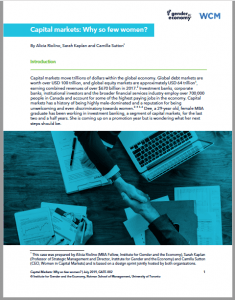Overview
This case was prepared by Alicia Riolino (MBA Fellow, Institute for Gender and the Economy), Sarah Kaplan (Professor of Strategic Management and Director, Institute for Gender and the Economy) and Camilla Sutton (CEO, Women in Capital Markets) and is based on a design sprint jointly hosted by both organizations in the fall of 2018 at the Rotman School of Management. (Learn more here.)
This case would be useful for those interested in or teaching courses in:
- Gender analysis in the business context
- Financial services
- Capital markets
- Human resources
- Women’s empowerment
Introduction
Capital markets move trillions of dollars within the global economy. Global debt markets are worth over USD 100 trillion, and global equity markets are approximately USD 64 trillion, earning combined revenues of over $670 billion in 2017. Investment banks, corporate banks, institutional investors and the broader financial services industry employ over 700,000 people in Canada and account for some of the highest paying jobs in the economy. Capital markets has a history of being highly male-dominated and a reputation for being unwelcoming and even discriminatory towards women.
To increase representation and reduce turnover for women and other underrepresented groups, many banks and financial institutions have implemented diversity and inclusion hiring and retention programs. These programs have helped to improve hiring at junior levels, with some institutions hiring at a balanced workforce at entry levels. However, for most firms the results at the mid and senior levels are still lacking. While the number of women entering capital markets has increased, few are rising to the top or advancing beyond Associate and Vice President roles. The main interventions, such as mentoring programs, unconscious bias training and more systematic promotion processes, have not yielded strong results. Consequently, representation in leadership has been slow to increase. Capital markets organizations need an effective, long-term solution to retain diverse talent. The question is, how can capital markets foster an environment that is inclusive and supports career advancement for women as well as men? What can leaders or team members do to promote an environment that is hospitable for its workforce and supports diversity?





